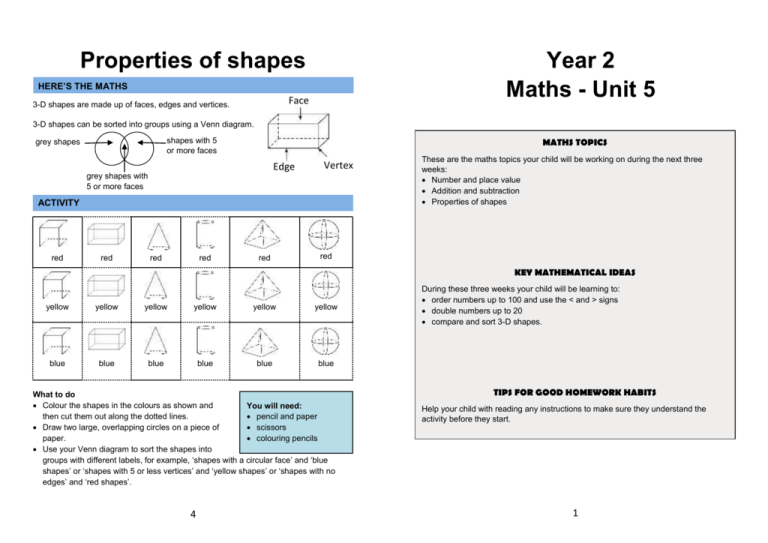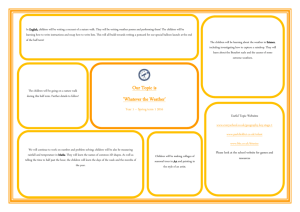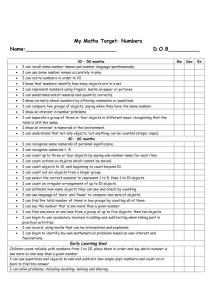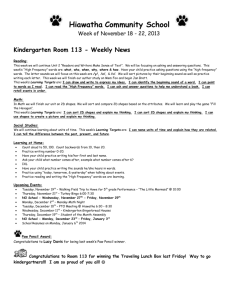Maths Newsletter 5
advertisement

Properties of shapes Year 2 Maths - Unit 5 HERE’S THE MATHS Face 3-D shapes are made up of faces, edges and vertices. 3-D shapes can be sorted into groups using a Venn diagram. shapes with 5 or more faces grey shapes MATHS TOPICS Edge Vertex grey shapes with 5 or more faces ACTIVITY red red red red red These are the maths topics your child will be working on during the next three weeks: Number and place value Addition and subtraction Properties of shapes red KEY MATHEMATICAL IDEAS yellow yellow yellow yellow yellow yellow blue blue blue blue blue blue What to do Colour the shapes in the colours as shown and You will need: then cut them out along the dotted lines. pencil and paper Draw two large, overlapping circles on a piece of scissors colouring pencils paper. Use your Venn diagram to sort the shapes into groups with different labels, for example, ‘shapes with a circular face’ and ‘blue shapes’ or ‘shapes with 5 or less vertices’ and ‘yellow shapes’ or ‘shapes with no edges’ and ‘red shapes’. 4 During these three weeks your child will be learning to: order numbers up to 100 and use the < and > signs double numbers up to 20 compare and sort 3-D shapes. TIPS FOR GOOD HOMEWORK HABITS Help your child with reading any instructions to make sure they understand the activity before they start. 1 Number and place value HERE’S THE MATHS < means ‘less than’ HERE’S THE MATHS > means ‘greater than’ = means ‘equals’ or ‘is equal to’ The wider part of < and > belongs next to the larger number and the narrow point belongs next to the smaller number, e.g. 39 < 68 (39 is less than 68) and 68 > 39 (68 is greater than 39). ACTIVITY What to do You will need: Player 1 chooses a number between 1 and 100. pencil and paper Player 2 guesses what they think the number might be. For each guess, Player 1 says whether their chosen number is less than or greater than Player 2’s guessed number. Player 2 should write down the reply using the correct < or > sign so that they can keep track of their guesses and Player 1’s responses. For example, < 65 or > 32 where represents Player 1’s chosen number. Play continues until the number is correctly guessed. Swap roles and play again. Variation Set a maximum number of guesses so that there is a winner for each game. QUESTIONS TO ASK If two numbers have the same number of tens, how do you know which number is less/greater than the other? Addition and subtraction How do you know which number is less/greater than the other? How do you know which sign to use in between the two numbers? What is the best number to choose for your first/next guess? Your child has been practising doubling numbers to 20. Knowing doubles facts is very useful as part of your child’s mental maths skills. For children who are working towards fluently knowing the facts, encourage them to learn doubles to 10 first and then use those doubles to help them to double numbers between 11 and 20. For example: double 13 = double 10 + double 3 = 20 + 6 = 26 double 17 = double 10 + double 7 = 20 + 14 = 34 ACTIVITY What to do Write even numbers from 2 to 40 on a single piece You will need: of paper (randomly dotted around and spread out pencil and paper on the page). 20 small pieces of Shuffle the 1 to 20 number cards and place them paper with the numbers face down. 1 to 20 written on them Play ‘Find it First’ by turning over the top number card, doubling the number and pointing to the answer on the piece of paper. The first to point to the correct answer wins a point. Repeat for other number cards. The winner is the player with the most points when all the number cards have been used. Variation Each player competes to be the first to write the answer on their own piece of paper rather than pointing to the answer. QUESTIONS TO ASK What is double X? What is X plus/add X? How did you double that number? 2 3 What is two times X?









